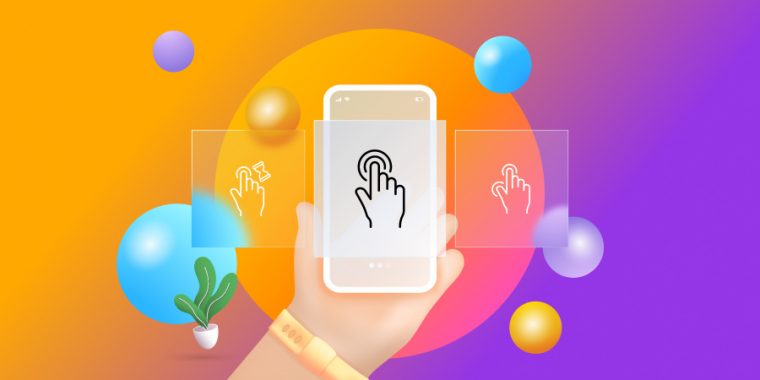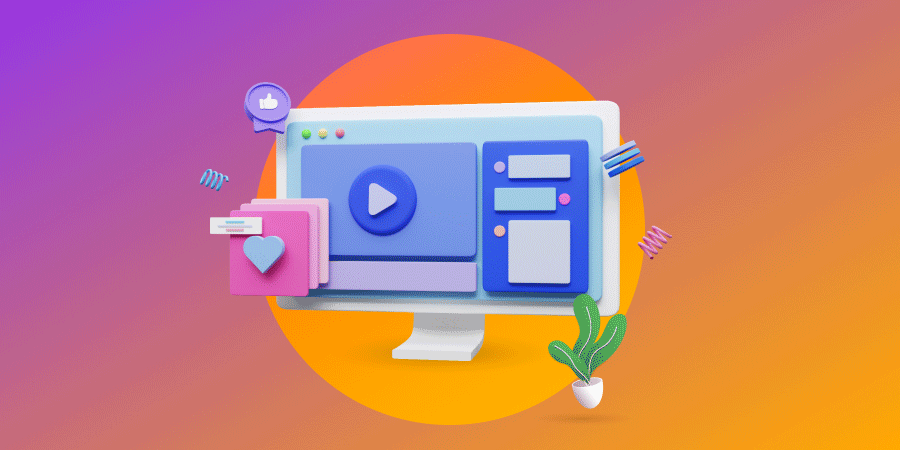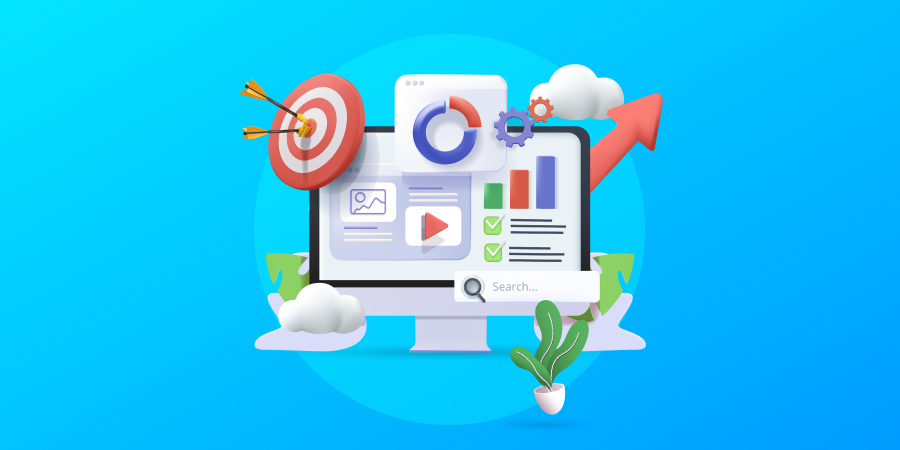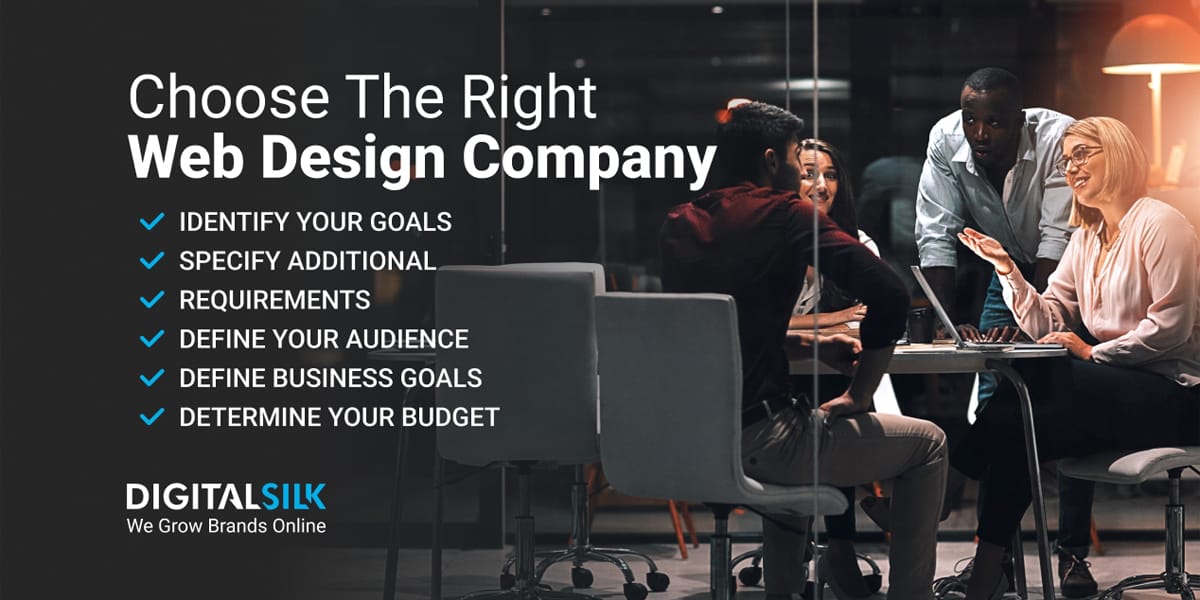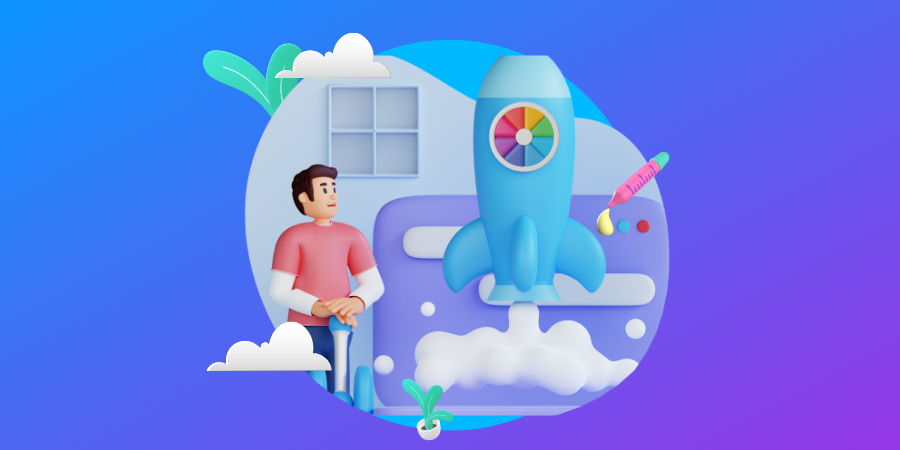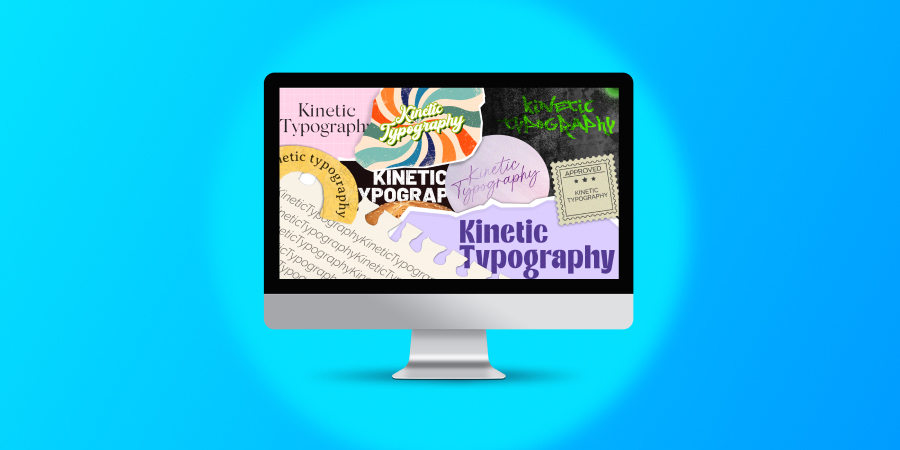Ever wondered how some websites seem to dance, play and evolve as you scroll through them? That’s not just good design – that’s the power of scrolling effects in action.
We’ll break down what scrolling effects are, the most common types used in web design, best practices and the incredible benefits they can bring to your website.
What Are Scrolling Effects?
When browsing the web, you’ve probably stumbled across websites that change in appearance or behavior as you scroll.
These changes, dictated by the position of the scroll bar and triggered by various actions, are referred to as scrolling effects.
They can transform a static webpage into a dynamic experience, motivate your visitors to engage and help you tell an immersive story.
According to Nielsen Norman Group, 74% of visitors engage with content within the first two screen lengths. By incorporating dynamic scrolling effects, you increase the probability of captivating these visitors, encouraging them to continue their scrolling journey, thus exploring more of what the site has to offer.
Types Of Scrolling Effects
When implemented well, scrolling effects create depth and make a website stand out.
Nine of the most common types of scrolling effects include:
- Parallax scrolling: This effect creates the illusion of depth by making the background content (usually an image) move at a different speed than the foreground content while scrolling.
- Fade-in or fade-out: Elements on a webpage can appear (fade-in) or disappear (fade-out) as a user scrolls down or up the page.
- Zoom in or out: Images or other elements can increase or decrease in size as a user scrolls.
- Sticky elements: As you scroll, certain elements, like a navigation bar, can stick to the top or side of a viewport, making them accessible from anywhere on the page.
- Reveal animations: As visitors scroll, elements can slide, rotate, bounce or employ other animations as they come into the viewport.
- Scroll-triggered background changes: The background color or image can change based on the scroll position.
- Scrolling progress bars: These indicate how much of an article or page the user has scrolled through.
- Multidirectional scrolling: Content can move both vertically and horizontally based on user interaction, offering a unique navigational experience.
- Pull-to-refresh scrolling: Common in mobile apps, pulling down at the top of the content refreshes it.
Think you can remember the definitions above without reading the answers?
Test your knowledge with our quiz below!
#1. Which answer correctly defines parallax scrolling?
#2. Which answer correctly defines reveal animations?
#3. Which answer correctly defines multidirectional scrolling?
Results
Congrats, you’re now an expert at scrolling effects!
Are you interested in the impact of scrolling effects on your website?
Meet with our web design experts to tell us about your unique project requirements!
Better luck next time.
Still interested in the impact of scrolling effects on your website?
Meet with our web design experts to tell us about your unique project requirements!
Benefits Of Website Scrolling Effects
Scrolling, when executed well, can transform a routine content scroll into a journey of discovery, bringing many benefits to a website that can capture visitors’ attention.
Common benefits that these effects bring to the table are:
- Enhanced user engagement: By introducing movement and interactivity, scrolling effects can grip visitor’s attention, making them more likely to spend additional time exploring a site.
- Improved storytelling: Websites, especially those that aim to tell a story or present a narrative, can leverage scrolling effects to create a more compelling flow and progression, guiding visitors naturally from one section to another.
- Added depth and dimension: Techniques like parallax scrolling can introduce a sense of depth, making the webpage feel more like an interactive environment rather than a flat canvas.
- Highlights key content: Strategic use of scrolling effects can draw the eye to essential information, products or calls to action, ensuring that visitors don’t overlook crucial content.
- Improved aesthetics: A well-designed scroll effect can elevate the overall look and feel of a website, making it stand out in a sea of static pages.
- Boosted brand image: Innovative and sleek scrolling effects can position a brand as modern, forward-thinking and tech-savvy, appealing to a demographic that values design and functionality.
- Increased conversion rates: By guiding visitors through a seamless and interactive journey, scrolling effects can indirectly influence their behavior, potentially leading to higher conversion rates.
- Encouraged content exploration: Visitors are more likely to explore further down the page when captivated by engaging scrolling effects, ensuring that more of the site’s content gets seen.
Best Practices For Using Scrolling Effects
Scrolling effects can breathe life into a website, but just like any powerful tool, they must be used wisely. Improper use can overwhelm visitors or even detract from the content you’re trying to emphasize.
The most common best practices for using scrolling effects include:
1. Prioritize Performance
Ensure your scrolling effects don’t slow down page loading times. Visitors value speed, and a beautiful effect that causes lag can quickly become a frustration.
Tools like Google’s PageSpeed Insights can give insights into how well your site performs and offer suggestions for improvement.
2. Avoid Overuse
While scrolling effects can be captivating, using too many on one page can overwhelm visitors. It’s better to use them strategically to emphasize key points rather than making every element of the page interactive.
Before implementing any scrolling effect, ask, “What purpose does this serve?” If it doesn’t enhance the storytelling or user experience, reconsider its inclusion.
3. Test Across Devices
Always test scrolling effects on various devices and screen sizes. What looks good on a desktop might not translate as effectively on a mobile device.
For instance, parallax effects or animations might be misaligned or cropped on smaller or larger screens.
Tools like BrowserStack or the device emulation mode in Chrome DevTools can help simulate how a website looks and behaves on various devices and browsers.
4. Stay Accessible
Ensure that your website remains accessible to all visitors, including those with disabilities. Scrolling effects should not hinder the ability of screen readers or other assistive technologies to interpret and navigate your content.
A good solution is to allow visitors to turn off or reduce motion. This can be done through a setting on the website or by respecting the ‘prefers-reduced-motion’ media query set at the system level by visitors.
You can also familiarize yourself with the Web Content Accessibility Guidelines (WCAG) and strive to meet its criteria, especially those related to animations, motion and functionality.
5. Provide Intuitive Navigation
If you’re using scroll effects to change content or move between sections, always provide an intuitive way for visitors to navigate. This can include visible navigation menus, scroll indicators, or arrows.
Conduct usability tests to see how real visitors navigate your site with the scrolling effects. Gather feedback and be prepared to make adjustments based on their experiences.
6. Maintain Focus
The primary goal of your website is to convey information or encourage a specific action. Make sure that any scrolling effects support this goal and don’t distract from your primary message or call to action.
Always design with your content as the priority. Scrolling effects should be the icing on the cake, enhancing the user’s journey through your content, not replacing or overshadowing it.
7. Be Mindful Of Motion Sickness
Some visitors may experience motion sickness or discomfort from certain animations or parallax effects. Always provide an option to disable or tone down these effects for sensitive visitors
You can also consider informing visitors before they engage, allowing them to decide if they want to proceed.
8. Keep SEO In Mind
Ensure that your use of scrolling effects doesn’t harm your search engine optimization efforts. For instance, if large portions of your content appear on scroll, search engines might not index them.
Also, heavily animated websites can be resource-intensive, slowing down the page load time. Page speed is a confirmed ranking factor, so slower pages might not rank as well.
9. Get Feedback
Before finalizing your design, gather feedback. This can be from colleagues, target audience members, or usability testers. They can offer insights into how the effects are received and if they enhance or detract from the experience
Tools like UserVoice or Hotjar allow visitors to provide feedback directly on your site, sometimes even allowing them to highlight specific elements they’re referring to.
10. Stay Updated
Web design trends evolve, and what’s trendy today might be outdated tomorrow. Always stay updated with the latest in design and technology to ensure your scrolling effects remain relevant and effective.
For example, the evolution of CSS and JavaScript libraries has enabled more sophisticated animations and interactions.
Our experts build custom websites. Schedule A Consultation
10 Best Examples Of Scrolling Effects
Here are ten stunning examples of scrolling effects, including those from our Digital Silk portfolio, showcasing a range of techniques and styles that designers have used to enhance the user experience.
1. Apple’s AirPods Pro
Apple is known for its sleek designs, not just in products but also in its web presentations. Their product pages such as the Apple AirPods Pro product page often use parallax effects, animations and zooming to highlight product features as you scroll.
2. Wodwo
We had the privilege of designing the digital presence for Wodwo — a revolutionary AI Audience Modeling Platform tailored specifically for marketers.
Our team crafted an engaging website for the brand, leveraging innovative scrolling effects to seamlessly guide visitors through the platform’s prowess and benefits.
3. Every Last Drop
This single-page website was crafted by Nice and Serious, a B Corp-certified creative agency dedicated to producing content and campaigns solely for impactful projects.
The Every Last Drop website takes visitors on a journey through a day in the life of an average person, revealing how much water is used in daily activities — from the morning routine to the end of the day. The purpose is to demonstrate that water consumption extends beyond just what we drink.
4. Tecnam
Digital Silk was honored to partner with Tecnam, a titan in the aviation industry with a fleet of over 7,500 airplanes worldwide.
We crafted a captivating, animated website journeying through the illustrious history of Tecnam and their deep-rooted aviation expertise.
5. Porsche Evolution
Porsche is a renowned German automobile manufacturer that specializes in producing high-performance sports cars, SUVs, and sedans. They wanted their fans to learn more about the brand’s history through interactive design, so they created Porsche Evolution.
This microsite uses vertical scrolling to take visitors on a journey through the history and evolution of Porsche vehicles. The site also uses dynamic animations, such as the sound of engines or race visuals, activated by scrolling, to dive deep into the brand’s success in racing events.
6. Welch’s Fruit Snacks
For Welch’s Fruit Snacks, visitors are treated to a delightful experience where individual fruit snacks spring to life on-screen, dancing and moving about, only to eventually find their way into their iconic packaging.
Our collaboration with Welch’s aimed to capture the fun essence of the brand, merging it with a digital experience that’s as engaging and vibrant as the fruit snacks themselves.
7. The Boat
The Boat website was made to commemorate the 40th year since the fall of Saigon and to mark four decades of Vietnamese integration in Australia.
They made an interactive novel, where scroll effects are used to navigate the story, with animations, shifts in perspective, and even ambient sound effects enhancing the reading experience.
As you journey through each section, the parallax effect enhances the sensation of flipping through the pages of a book.
8. Venator Sales Group
One of our clients, Venator Sales Group, wanted to build a website that showcases their online platform and creates an engaging experience while scrolling.
As visitors scroll through the website, they’re met with subtle yet captivating image transitions, moving elements and simple animations.
This blend of simplicity and digital artistry perfectly complements Venator’s ethos, showcasing their services in a compelling and accessible manner.
9. Canals Amsterdam
The Canals Amsterdam website, a collaborative project by designers Marcus Brown from Amsterdam and Aristide Benoist from Malaga, leverages the history of Amsterdam’s canals to showcase a narrative through web-based storytelling
This site educates visitors about Amsterdam’s UNESCO-protected canal ring. As you scroll, you’re taken through different historical eras, with animations and facts popping up along the way.
10. XceeDance
Xceedance is a global provider of consulting, technology, and managed services for insurance organizations. They specialize in helping insurance companies with their operational, technology, and analytical needs.
We partnered with Xceedance to create a custom-designed website, enriched with immersive scrolling effects.
As visitors navigate through the site, they’re taken on a historical journey, starting with the pivotal Great Fire of London in 1666. This catastrophic event, while devastating, gave birth to the very concept of property insurance.
Build A Custom Website With Digital Silk
At Digital Silk, we’re more than just a web design agency; we’re digital consultants, weaving together expertise in UX design, branding, content creation and web development.
Every pixel we craft is backed by thorough industry insights, competitor analysis and market research, ensuring a digital tapestry that vividly represents your brand and resonates with your audience.
At Digital Silk, our web design services include:
- Custom web design: Our expert team crafts unique websites, creating custom UX/UI designs with SEO to amplify visibility, engagement, and conversion rates.
- Custom redesign services: We use our expertise in revamping your online visibility, encompassing strategic direction, tailored UX/UI design, and SEO best practices to escalate your online position.
- Custom eCommerce design: Proficient in major eCommerce platforms, we create intuitive, enriched e-stores, extending consistent support from design inception to marketing and ongoing maintenance.
- Custom creative web design: Our designs transcend mere visuals. We strategically employ color, animation, typography, and visuals to align with specific website objectives.
- End-to-end custom development: We architect brand-cohesive websites on top-tier platforms, ensuring detailed planning, SEO, user-centric UX/UI design, development, and a user-friendly CMS tailoring.
Contact our team at Digital Silk today. Let us paint the digital canvas with a custom-designed website and engaging graphics, ensuring a user experience that’s as seamless as it is unforgettable.
"*" indicates required fields


